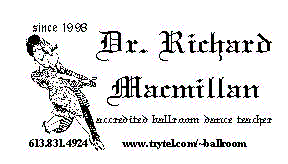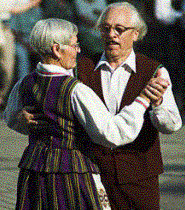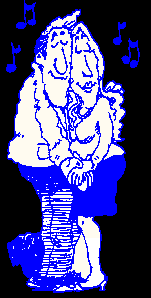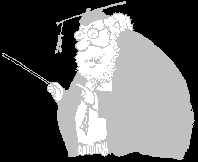PHYSICAL & MENTAL HEALTH IN BALLROOM DANCING

Richard W. Macmillan, Eng.D., B.A. (Honours Psych)
Accredited ("Grande Distinction") by the Perron School of Dancing (Ottawa)
Teaching in the Stittsville/Goulbourn area since 1998!
Stittsville (Ontario) and district; 613.831.4924
welcoming dancers from Kanata, Carleton Place, Smiths Falls, Perth, downtown Ottawa, or wherever!
"As I have experienced it, ballroom dancing is the total immersion of a
couple in the precision and grace of musical expression. Owing to its
contribution to good health through pleasurable exercise and the relief of
stress, it is surely a key to longevity; and through the ever-expanding circle
of good friends and acquaintances it is a constant source of well-being and
social development."
PHYSICAL HEALTH
 Frontal view of the heart
Frontal view of the heart
At the present time there are over 3,640,000 Google results on the Internet relating to the
health benefits of ballroom and Latin-American dancing. Although some are of little value, there
are many which relate to actual medical studies and provide valuable information for the
improvement of both physical and mental health.
Most of the better articles (e.g., from the New England Journal of Medicine, the Mayo Clinic
and Columbia University) emphasize the cardiovascular and respriratory benefits of ballroom and
Latin (B&L) dancing, as well as increasing muscle tone, stamina, flexibility, coordination and
balance. There are about 17 B&L dances on the programmes of dance evenings around the City
(see Ballroom Dancing in our Area). These dances range from slow
(Rumba, Bolero, Slow Waltz and Foxtrot) to moderate (Cha-Cha, Tango, Merengue, Bachata
and Swing) to very fast (Viennese Waltz, Quickstep, Jive, Samba and Salsa). Before learning
to dance, it is always advisable to have a complete physical examination. If any serious medical
conditions exist, or if edlerly and/or sedentary, it may be wise to avoid the faster dances.
The ballroom dances make frequent use of long steps, often taken from the heel with a straight
knee, to cover the length of a ballroom floor. The Slow Waltz includes much bend-and-rise
(typically a long step from a bent knee on Count 1 and up on the toes for Counts 2 and 3) which
provides excellent exercise even at a slow tempo. This is also true of the Quickstep (not for
beginners!) which typically consists of down-movements on "slow" (two-beat-) steps and
up-movements (toes) on the "quick" (single-beat-) steps. The Viennese Waltz consists
of rapid full turns which - even after two minutes - may leave you dizzy and out of breath!
The most popular dances at the present time, however, are the Latin-American, which
include Rumba, Bolero, Cha-Cha, Mambo, Merengue, Bachata, Samba, Salsa and Argentine
Tango. Because of similaries in technique, the Swing dances (East Coast Swing, West Coast
Swing, Jive, Hustle, Lindy Hop, etc.), all of North American origin, are also considered to be
part of the Latin dance group. Except for the Samba, the Latin dances usually do not require
much floor space, but provide at least as much good exercise as the ballroom dances. This is
largely due to "Cuban Movement".
What is Cuban Movement??
No matter whether the next step in a dance is forward, backward,
to the side or in place, the step is first taken without weight, using a bent
knee and only the ball of the foot. Once the foot has been placed, the
heel is lowered and the body weight is transferred to the foot while bending the other knee in
preparation for the next step. You can practice this by marching in place, keeping the balls of the
feet on the floor.
 KNEE and BALL of the foot FIRST!
KNEE and BALL of the foot FIRST!
The alternate bending and straightening of the knees automatically causes the
hips to move. This is excellent exercise, and is a major point in the "Core
Rhythms" DVD course (with instructors from "Dancing with the Stars"). The Merengue basic
step is nothing more than a series of side steps, each step taken with Cuban Movement. Try this
around the room for even three minutes, moving only from the waist down, and
you will really feel it in your waistline!
The Rumba is a slow dance using Cuban Movement throughout. In my teaching I strongly
recommend that the Rumba be learned first. In addition to the constant slow-quick-quick Cuban
rhythm, it teaches you more about dancing than any other dance, using most of the movements
found in the faster Latin dances. Stamina permitting, you will find it easy to learn Cha-Cha and
Salsa once you have slowly practiced the movements of Rumba.
MENTAL HEALTH
 Never stop learning!
Never stop learning!
To increase or even maintain your mental faculties (intelligence), you must keep on learning
throughout your entire lifetime. Learning a foreign language or doing crossword puzzles may
help to maintain the nonphysical aspects of your intelligence, but your brain (above) also controls all
of your physical movements. Learning dancing acts upon both the physical and nonphysical
functions of the brain - and without drudgery!
When learning dancing ...
Although there is still a great deal that is not yet known about the human brain, it is clear that
dance steps are first communicated to us verbally and visually. The verbal part involves our
understanding of what is being said, and together with the movements that we see, we attempt
to translate this information into motions of our own (sometimes not very successfully!).
Initially, therefore, we have to talk to ourselves, both during the lesson and while
practicing. This self-talk and comprehension involves the speech areas (on the left side of the
head) and the reasoning area (the frontal lobe) of the head. We watch the instructor's
movements and the movement of our partner using the connection of the eyes to the occipital
lobe in the back of the head. The motor area of the upper frontal lobe indicates how we should
move, and the sensory area in the parietal lobe (just across from the motor area) confirms our
movements. Connection of the steps to the beats of the music also requires several areas of the
brain. As we attempt to memorize this complex combination of procedures, the hippocampus,
located in the temporal lobe, comes into play. Encoding the autidtory, visual and mechanical
information for a dance step does take time, however, depending upon how much you practice.
After your steps have been practiced ...
Yes, practice is necessary to become a good dancer, but even as little as 15 minutes per week,
with or without partner, will bring significant results. Once you have learned your steps, you can
relax and really enjoy your dancing. When memorized, the dance steps become
motor routines - like tying a shoe -, and this allows us to perform our movements
on "autopilot", simply by thinking briefly about what step you want to do, then letting the brain
execute the sequence automatically, with little or no active thought during its execution. Those
familiar with computer programming will note the similarity of this to calling a procedure or
subroutine. Motor routines are known to be stored in the cerebellum, a
ball-shaped structure at the back of the head. The cerebellum is commonly known as "muscle
memory".
If you know your dance steps really well, you can converse with your partner while dancing or
even sing along with the music (if your partner doesn't mind)! Still, the partners always have to
remain watchful to avoid colliding with other dancers or even stationary objects like tables, chairs
or walls. The man, as leader, is an on-the-spot choreographer - he must decide what step to do
next. Will this next step keep the dance interesting for his partner and himself (and possibly also
for any observers), and will there be there enough space on the floor to do it? Yes, your mind
will be busy!
All of this may a lot to much to expect of anyone ...
and yet ballroom and Latin dance steps are designed for people of average intelligence.
Just a little practice, and your brain can cheerfully handle it! Although there are no guarantees
of freedom from stress, sadness or depression through dancing, a great many people have
found relief from negative moods, whatever they may have been. So, as dancers often wish
one another ... HAPPY DANCING!
With good physical and mental health ( and a little good luck) we have ...
LONGEVITY

The following article has been made available to my dance students over the past seven years:
THE OTTAWA CITIZEN - WORLD
Dancing to beat dementia
A U.S. study suggests that a regular spin on the dance floor can significantly cut the risk of
dementia. Charles Enman reports:
If you want to keep your head clear, keep those dancing shoes on, according to a recent U.S.
study that suggests hoofing it three or four times a week may reduce the risk of dementia by
76 per cent.
The study by the Albert Einstein College of Medicine in New York City showed much less
benefit from other physical activities like walking, bicycling and swimming.
"If you're surprised, so am I,"
Dr. Joe Verghese [MD], lead author of the study, told the Citizen.
"I expected a number of physical activities to be protective — and I had no idea we'd find that
dancing would have the strongest effect."
The study looked at the effects of 10 other physical activities, including walking, stair climbing,
bicycling, swimming, even housework. Most of them seemed completely ineffective.
The study also looked at cognitive activities like doing crosswords, playing musical instruments
and reading. Many were found to reduce the risk of dementia.
"That's logical", Dr. Verghese said,
"since mental activity works the mental muscles that dementia weakens. And maybe,
" he adds,
"the mental component of dancing accounts for much of its protective effect."
"Dancing is really complex,"
he says.
"You follow step patterns, you follow the music, you coordinate with your partner. The mind's
really getting a workout."
"The more the mind is exercised, the greater its 'cognitive reserve',"
Dr. Verghese says.
"The buffer probably wouldn't prevent Alzheimer's or loss of cerebral circulation, but it would
delay, perhaps by a great degree, the symptoms."
By that argument, wouldn't housework offer protection?
"Sure," Dr. Verghese replied.
"You have to create a schedule, do your own shopping, arrange things around the home, so
there's lots of mental activities implied, but it only cut the risk by 12 per cent."
Walking, as exercise, and not as mere ambling, was the second most protective activity, cutting
dementia by 33 per cent.
A total of 469 people over age 75 were enrolled in 1980 and observed until they died or the
study ended in 2001.
"More than 20 years, that's a very long follow period,"
Dr. Verghese said.
The study presented a chicken-and-egg conundrum: Activity may affect dementia, but dementia
certainly affects a person's choice of activities.
In an ideal world, the study's authors would have begun with subjects who were dementia-free.
But dementia comes on slowly, sometimes taking seven years to become apparent. The solution
was to exclude anyone who showed symptoms in the first seven years.
By the end of the study, 124 of the subjects had developed dementia, half of them from
Alzheimer's and one-quarter each from strokes or hardening of the arteries. The rest either had
both factors or some rarely one.
Don't want to dance? Well, Dr. Verghese has comfort for you. Other studies have shown
dementia-averting effects in other activities. A decade ago, a French study found significant
protection in knitting, travelling and gardening.
Dr. Joe Verghese graduated from St. Johns Medical College, Bangalore, India in 1989. He then
completed postgraduate training in Internal Medicine and Neurology in United Kingdom. He
completed his Neurology residency at the Albert Einstein College of Medicine, Bronx, NY in
1998. He did fellowship training in Neurophysiology as well as Aging & Dementia in 1999 at
the same institution. He received a Master of Science degree in Clinical Research Methods with
Distinction in 2001. Dr Verghese is board-Certified in Neurology. Dr. Verghese is Professor of
Neurology, Murray D. Gross Memorial Faculty Scholar in Gerontology, and Director, Division
of Cognitive and Motor Aging. Dr. Verghese is a recipient of the Beeson award from the National
Institute on Aging and the Outstanding Scientific Achievement for Clinical Investigation Award
from the American Geriatrics Society. His research interest is the effects of disease and aging on
mobility and cognition in older adults, and he has had several publications in this area. His current
projects include studying the influence of cognitively stimulating activities on reducing risk of
dementia, the role of divided attention tasks such as walking while talking in predicting outcomes
such as disability and cognitive decline, and global health.
BALLROOM DANCING IN OUR AREA:

JACK PURCELL COMMUNITY CENTRE, Elgin at Gilmour, Ottawa.
Every Wednesday, 7:00 p.m. Admission: $4.10 per person (including snacks/coffee!)
Parking privileges free to participants. Music (computer controlled) much improved!
613.564.1050
CHINESE CANADIAN CULTURAL CENTRE, Kent at Florence, Ottawa.
Every Saturday, 7:30 p.m. Admission: $5. Ample parking on the street.
Good quality music (hen hao de yinyuč). And don't forget their Chinese New Years bash!
613.232.8403.
SMITHS FALLS, at the Orange Hall on William Street, typically on the last
Friday of each month. 8:00 to 10:30 p.m.; $5 per person, refreshments included; Contact
Suzanne Rebetez for further details: 613.253.2172
LET'S DANCE, 60 Colonnade Road N., Nepean. 613.723.6592
Every Friday, 9:00 p.m. Admission: $7 per person. L.L.B.O. licensed.
GLEBE COMMUNITY CENTRE, 690 Lyon Street S., Ottawa.
Sundays, 8:00 to 11.00 p.m. Admission: $10 per person; 613.564.1058.
PRIVATE INSTRUCTION (to Silver level):
In your own home (or mine), at your convenience! 613.831.4924
 Touch me with your cursor!
Touch me with your cursor!
Cha-Cha, Swing, Rumba, Samba, Mambo, Merengue, Foxtrot, Slow Waltz, Tango,
Quickstep, Viennese Waltz, Bolero, Salsa, Bachata, Paso Doble, Argentine Tango and
Slow Dance
Think about it ...
- You'll have my attention 100% of the time!
- You'll learn 2 to 3 times as much per hour as in a class - and with style!
- You choose the day and the hour (if not already booked).
- Couples, singles, or minigroups welcome!
- You choose the dances in which you are really interested!
- Dance in a pleasant, comfortable environment.
- Need to cancel/reschedule an hour? OK with 24 hours' notice.
- Getting married?? I'll get you ready!
Rates per hour (singles, couples or minigroups):
At my home: $30 (1˝ hours: $45; two hours: $55);
at your home, within a 20-km radius of Munster: $40 (1˝ hours: $55; two hours: $65);
at your home, within a 40-km radius of Munster: $50 (1˝ hours: $65; two hours: $75).
Where else could you find this?
... a six-hour package of private lessons for only $160 per couple!
Why not start a with some of your friends?
Think about it: two couples = $7.50/hour per person; three couples = $5/hour per person!
Home Page
RICHARD W. MACMILLAN - brief résumé:
Born in New York, 14 July 1941
Bachelor of Science, Electrical Engineering,
Polytechnic Institute of Brooklyn (New York), 1964
Master of Science, Electrical Engineering,
Columbia University (New York), 1969
Doctor of Engineering, Computer Science (Informatik),
Technische Universität Berlin (West Berlin), 1980
Bachelor of Arts (Honours), Psychology - Magna cum Laude,
University of Ottawa, 1993
--- Retired: 1998 ---
Intermediate Professional Examination, Ballroom Dancing,
Perron School of Dancing (Ottawa), July 1998
passed with "grande distinction".
October 1998: began teaching ballroom dancing for Goulbourn Township, now
Rideau/Goulbourn Ward of the City of Ottawa.
September 2002: organized first dance courses in the Carleton Place area.
December 2010: concluded teaching for the City of Ottawa.
18 January 2011







